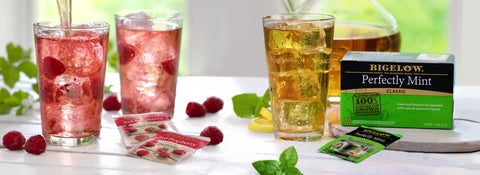Steeped in History: The Chronicles of Tea Including Bigelow Tea’s Innovations Over Time
 Tea has been a beloved beverage for centuries, enjoyed by people all over the world. But have you ever wondered how tea came to be such an important part of our culture? Let’s together take a journey through the history of tea, from its beginnings to its modern-day popularity, and discover how Bigelow Tea has played a role in this fascinating story.
Tea has been a beloved beverage for centuries, enjoyed by people all over the world. But have you ever wondered how tea came to be such an important part of our culture? Let’s together take a journey through the history of tea, from its beginnings to its modern-day popularity, and discover how Bigelow Tea has played a role in this fascinating story.
Tea’s Legendary Beginning
The history of tea can be traced back to ancient China, where it was first discovered over 2,000 years ago. According to legend, the Chinese Emperor Shen Nung, “The Divine Healer,” accidentally discovered tea when he was boiling water and leaves from a nearby tea plant fell into his pot. He enjoyed the resulting brew so much that he began to promote tea drinking throughout his kingdom. Over time, tea spread throughout China and became an integral part of Chinese culture as it became the subject of books and poetry and was a favorite drink of emperors.
Tea Expands Globally
Despite having a long history in China, tea did not arrive in Europe until the 17th century when Portuguese traders living in the East brought it with them when they traveled back home. In 1662, the royal bride, Catherine of Braganza, a Portuguese royal and tea enthusiast, traveled from Portugal to the United Kingdom to marry Charles II bringing with her several trunks of premium Chinese tea. It was then that the concept of teatime was officially introduced into British court and later fashioned into Afternoon Tea by Anna, Duchess of Bedford, who delighted in a light snack in the afternoon.
Tea eventually made its way to other parts of the world, where it grew to become a much-coveted luxury item among the British who then played a significant role in the global spread of tea, establishing tea plantations in the 19th century in India, Sri Lanka, and other parts of the world where tea became a global commodity, enjoyed by people of all cultures.
Tea’s American Roots
Richard Blechynden has often been attributed with making the first iced tea at the World’s Fair in St. Louis in 1904. As sales for his hot tea dropped while summer temperatures rose, he purportedly poured tea over ice to entice fairgoers. Some dedicated research tells another story, though, with iced tea’s roots reaching as far back as 1879, when Marion Cabell Tyree created a recipe for green tea over ice, which was published in a community cookbook called Housekeeping in Old Virginia. Later, in 1884, another recipe for iced black tea surfaced from the Boston Cooking School.
In addition to iced tea, the tea bag was also accidentally invented by an American in 1904 when tea and coffee importer Thomas Sullivan shipped his samples in small silk pouches to customers who then popped the bags right into hot water. Tea bags continue to be one the most popular ways to brew tea today.
The Historical Significance Of Bigelow Tea
Bigelow Tea is proud to be a part of tea’s rich history, with a legacy dating back to 1945 when Bigelow Tea founder, Ruth Campbell Bigelow was inspired by an early colonial tea recipe. With the idea of creating a better cup and after weeks of trial-and-error blending black tea with orange rind and sweet spices, she emerged with the first cup of specialty tea. Ruth gave the blend to friends who later told her the tea “was a source of constant comment,” and so the tea "Constant Comment" was named and a company was born. Eighty years and three generations later, this iconic secret tea recipe is still going strong and is a foundation of history and tradition for millions of Americans.
While the company can attribute its beginnings to Ruth Campbell Bigelow, it was David C. Bigelow, Ruth’s son, and his wife Eunice, who launched specialty teas to the mass market through grocery channels in the 1970s which changed the company’s direction in profound ways and paved the way for the future of tea in the U.S. Another notable milestone in their luminous careers was the development of the foil pouch that has become the accepted industry gold standard for protecting tea’s freshness and flavor.
Today, through the leadership of third generation president and CEO, Cindi Bigelow, Bigelow Tea continues to expand and transform the tea industry. To ensure that the finest teas and botanicals remain the highest of quality in the family’s tea recipes, Cindi visits and continues to build strong partnerships with gardens all over the world, all of whom are long time partners with Bigelow Tea. With this, Cindi has driven market expansion through product innovation that includes the Bigelow Tea Signature line of black tea, green tea and herbal tea, seasonal tea products, organic, Bigelow Benefits wellness teas and Immune Support teas that feature ingredients with functional benefits as well as Bigelow Botanicals Cold Water Infusions, gentle herbal infusions using cold water. Bigelow Tea produces 2 billion tea bags annually and includes over 150 flavors to choose from.
Tea in America
Following water as the most widely consumed beverage in the world, tea continues to gain popularity. In fact, in the United States alone, over 159 million people drink tea every day, enjoying a cup for its flavor, health benefits, and ability to provide a moment of calm in an otherwise hectic day.
While the history of tea is a long and fascinating one, with roots that stretch back thousands of years, Bigelow Tea is proud to be a part of the developing story of tea by offering delicious blends that honor the rich traditions of tea while embracing the modern-day wellness needs of tea drinkers everywhere. The next time you enjoy a cup of Bigelow Tea, take a moment to savor the history and heritage that goes into each and every sip.
















